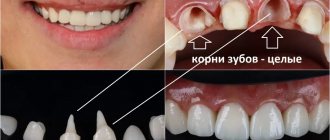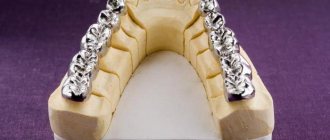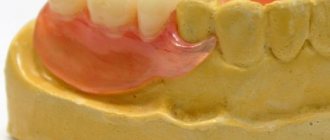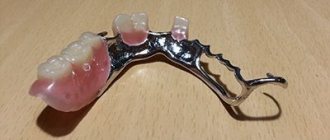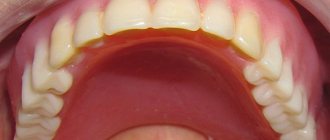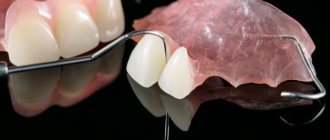The use of metal-ceramic crowns in the prosthetic procedure makes it possible to restore the natural anatomical configuration of a damaged tooth, its functionality, and also its aesthetic appearance. The price of metal-ceramic crowns is quite affordable and therefore this prosthetic option is incredibly popular among most patients in dental clinics.
In the article we will talk in detail about the process of installing metal-ceramic crowns on a tooth: we will consider the types of structures, indications and contraindications for their use, and also find out how much a metal-ceramic crown costs at Vanstom Dentistry in Moscow.
Metal-ceramic crown: design features
An orthopedic prosthesis made of metal-ceramics is a special onlay that is worn during the prosthetic procedure on a tooth that has previously been subjected to the grinding process. The shape of the metal-ceramic crown is identical to the anatomical configuration of natural teeth and repeats it down to the grooves on the tooth surface.
If you look at the photo of the metal-ceramic crown that we posted below, you will see that the base for creating the structure is a solid metal frame and the thickness of its walls can reach 0.5 millimeters. The contours of the frame are similar to the contours of the “native” tooth. On top, the frame base is covered with a layer of ceramics, which matches the color of the natural enamel coating.
Fixation of metal-ceramic crowns is carried out by fixing them on the prepared tooth using a special cementing composition.
How long will metal ceramics last?
One of the advantages of metal-ceramic crowns is their long service life. The product will retain all its positive characteristics for more than 12 years. However, there are several factors that can affect the duration of use of metal ceramics.
Among them:
- The quality of the original prosthetics. It is important that the dentist grinds the required amount of ceramics and performs the treatment. There should be no inflammation, swelling or other signs of disease at the installation site.
- An orthopedist must be a professional. It is important that the enamel is ground correctly and that there are no external defects left on the tooth, including small irregularities and bumps. If there are any unevenness, food will get into these grooves, which will create problems with the microflora and the crown.
Also, the patient himself must follow the rules for using metal ceramics so that your new tooth does not break or become damaged.
Materials for the manufacture of metal-ceramic crowns
Metal alloys
To produce the frame of a metal-ceramic crown in modern dentistry, three types of alloys from different metals are used:
1. Alloys of cobalt and chromium, nickel and chromium. The cost of a metal-ceramic crown made from these alloys will be as low as possible, but it is worth knowing that the listed metals often cause allergic reactions and irritation of gum tissue, and therefore the savings obtained when installing them are questionable.
2. Alloys of palladium, platinum and gold. This material for the production of prosthetics has a number of advantages: hypoallergenic, the ability to create the most natural tone of the prosthetic structure, which is especially important in the process of restoring teeth included in the smile line.
Another type of alloy that is used in the production of metal-ceramic crowns is a mixture with titanium as a base. Titanium alloys are not capable of causing allergic reactions; when used, the risks of rejection and incompatibility of the prosthesis with the tissues of the oral cavity are minimal.
Metal-ceramic crowns
from 8000 rub. More about prices
We have been working since 1994
we are one of the first to open private dentistry in Moscow
Best materials
only new and modern equipment for dental treatment
Free
consultation with a dentist
Payment options
- cash
- plastic cards
- cashless payments
Doctors' experience
- with great experience
- graduated
- conference participants
Content:
In modern orthopedic dentistry, a metal-ceramic tooth crown is one of the most popular and versatile types of prosthetics. Inside is a durable metal base made of chrome, cobalt, nickel or gold. Outside – aesthetic ceramics.
In this article we will tell you in detail what are the features, pros and cons of metal-ceramic crowns? What is the cost of metal-ceramic crowns in Krasnodar? How does the installation work? What should be done to extend their service life?
Metal-ceramic crowns before and after photos of our patients
Photo before
Photo after
Ceramic coating
The metal frame of the orthopedic structure is covered with a layer of dental ceramics, which in composition is almost similar to household ceramics, however, the compositions for lining metal-ceramic crowns contain an increased content of components such as albite and orthoclase, which increase the strength of the created layer.
The ceramics are applied to the frame in layers and specialists use a special tool for this work. After applying the next layer, the structure is fired in a vacuum oven. This is necessary to ensure the strongest possible adhesion of the ceramic layer to the frame.
Reviews of metal-ceramic crowns from patients indicate that this type of dental orthopedic structures is not only strong and durable, but also highly aesthetic, which makes it possible to regain an attractive and natural smile!
How to properly care for crowns?
The duration of use of metal ceramics directly depends on whether the patient is ready to follow the rules of care for them. There are several basic requirements:
- Regular proper brushing of teeth. The standard cleaning frequency is twice a day. In this case, you should move the brush vertically, from the gum to the edge.
- Careful selection of brushes. You will need to use a model exclusively with soft bristles. Pasta doesn't matter.
- Use dental floss. The space between the teeth should be cleaned especially thoroughly.
- Buy a rinse aid. It can also be replaced by regular rinsing with regular purified water.
If you smoke, often drink tea, coffee and other types of drinks with strong coloring ingredients, it is worth making an appointment for professional cleaning - at least twice a year.
Otherwise, care and precautions are the same as for everyday life without metal ceramics. It is better to eat solid foods carefully and not to overindulge in too cold or hot foods and drinks.
Indications and contraindications for the installation of metal-ceramic crowns
Installation of a metal-ceramic crown is indicated in the following circumstances:
1. If there is a need to reconstruct damaged teeth to restore full chewing function and aesthetic appearance.
2. Metal-ceramic crowns are indicated for installation in case of abnormal position of teeth in a row, to eliminate a number of aesthetic defects: discoloration of natural enamel, severe chips.
Like any other medical procedure, prosthetics with metal-ceramic structures also has a number of limitations:
1. Metal-ceramic crowns cannot be installed if you are allergic to metal alloys.
2. You should refrain from the procedure if you have weak and painful gums, periodontal diseases, or malocclusion.
Metal-ceramic crowns are not placed on young patients under 16 years of age.
Advantages and disadvantages
Like any type of orthopedic structures, metal-ceramic dental crowns have certain positive and negative qualities.
Pros of crowns
The advantages of crowns with a metal frame and ceramic outer coating are as follows:
- To install a prosthesis, there is no need to remove a natural tooth. It remains completely, with the exception of the layer ground to the thickness of the structure;
- metal ceramics can withstand high loads and maintain structural stability when eating solid foods;
- increased strength ensures the quality and durability of structures, which allows them to be installed on chewing teeth;
- with proper execution of products, there is no free space between the gums and the crown. The prosthesis turns out to be one-piece and fully corresponds to the structure of the natural tooth;
- the material is not dyed, so even with long-term use, the color of the coating does not change and does not distort the beauty of the smile;
- metal ceramics do not cause harm to the human body and are suitable for almost every patient;
- with proper care, structures made of metal alloys with a ceramic finish can last up to 15 years or more;
- caries does not form on the prosthesis, it is not a source of spread of harmful bacteria;
- external attractiveness. Metal-ceramic dentures imitate natural enamel as much as possible and are in no way different from natural teeth.
Speaking about the advantages, one cannot fail to mention the cost of the products, which is much lower in comparison with other types. When it comes to permanent prosthetics, metal-ceramics as a material is considered one of the best options.
Cons of crowns
Along with numerous advantages, the designs also have some disadvantages. These include:
- the need for depulpation of soft tissues and grinding of the hard enamel coating;
- under excessive loads, chips may appear on the ceramic layer;
- if the frame is made from inexpensive materials, then they can be translucent and such products will look unsightly on the front teeth;
- the possibility of allergic reactions in some patients due to individual intolerance to the constituent components.
In most cases, these disadvantages are invisible, and the prosthetics themselves allow you to achieve an excellent final result.
The process of installing metal-ceramic crowns
The main task of a specialist in prosthetics using metal-ceramic crowns is the accurate reconstruction of the root part of the tooth and its crown part. This is essential for completely restoring the functionality of the tooth.
In the restoration of the root part of the tooth, the following can be used:
- Stump inlays. Their use is advisable when the tooth root is healthy and does not have significant damage;
- Dental implant in cases of lost root part.
The prosthetics process takes place in two main stages, which are worth talking about in more detail.
How are crowns placed on one tooth?
A common installation option is to mount it on one tooth.
This solution is suitable if your own tooth is already heavily affected by caries or has many chips and cracks.
When choosing a specific design, the doctor takes into account the condition of the tooth and how damaged it is.
There are several main options:
- When the root or remains of more than half of the natural tooth are intact. In this case, it will be possible to do without special structures, only with a crown installed on top. Before installation, it is necessary to carry out filling, grind off the base and perform depulpation.
- The coronal part was completely destroyed. To decide on installation, you will need to check the current state of the root system. In this case, the crown is placed on a special pin. It is fixed in the root canal and cemented.
- The tooth is completely destroyed. In this case, a standard implant is used. A crown is placed on a previously prepared base, which takes root over several months. There are different implantation options, including one-stage implantation.
With one crown, you can not only restore chewing ability, but also completely restore the aesthetics of your smile.
Free consultation on the cost of treatment in our dentistry
Leave a request and the clinic administrator will contact you within 15 minutes!
Preparatory stage:
1. The patient comes for examination to a specialist. After assessing the condition of the tooth and a series of studies, the dentist makes a decision on the prosthetic technique.
2. If the root part of the tooth is alive, then it is possible to carry out a series of therapeutic manipulations, during which the specialist eliminates all inflammatory and destructive processes, if necessary, the dental canals are re-filled and a pin is applied.
If the tooth root is significantly weakened, then the pin cannot be used, and in this case, before installing a metal-ceramic crown, the specialist uses a stump spacer, designed to replace bone tissue that has undergone the process of destruction.
3. If the root of a tooth is missing or severely damaged, a dental implant must be installed. A metal-ceramic crown on an implant will cost more than other options, but this type of prosthesis has maximum durability and strength and is visually indistinguishable from natural teeth.
After all clinical training activities are completed, the second stage of prosthetics begins - laboratory.
Laboratory stage of installation of metal-ceramic crowns:
During the laboratory stage of prosthetics with metal-ceramic crowns, the structure itself is manufactured. The process consists of the following stages:
- Taking impressions of the patient’s teeth;
- Modeling of the structure frame;
- Trying on the finished prosthesis;
- Correction of possible defects.
The process ends with the installation and fixation of a metal-ceramic crown.
How to place crowns on all teeth
This method of prosthetics is also suitable if several teeth are missing at once. In this case, the dentist will install a bridge.
The main condition is the presence of healthy teeth on which the structure could be fixed.
If there are none or the roots are not in the best condition, the only way out of the situation will be to implant support pins.
The cost and duration of production will depend on the current condition of the patient. All work may take several months. In this case, a temporary structure is installed that can be changed after some time.
Prices for prosthetics with metal-ceramic crowns in Moscow
Moscow dentists offer different prices for metal-ceramic crowns. Prices for the service depend both on the clinic’s pricing policy and on a number of completely objective factors, including:
- Material for the manufacture of metal-ceramic crowns;
- The complexity of the clinical stage of preparation for prosthetics. Metal-ceramic crowns on an implant will be the most expensive option, since the process of installing them is a specific and complex task.
Do you want to restore lost teeth by installing metal-ceramic crowns? Contact our Vanstom dental clinic in Moscow: we guarantee high quality work in which we use modern materials and technologies, and will also pleasantly surprise you with affordable prices for metal-ceramic prosthetics.
Stages of metal-ceramic prosthetics
Any types of dental crowns are installed in stages and metal-ceramic products are no exception. It is important not only to install prostheses in a high-quality manner, but also to properly prepare for prosthetics.
Therapeutic stage
The quality characteristics of prosthetics directly depend on the correctness of therapeutic procedures. The essence of preparatory therapy is as follows:
- diagnostic measures. An x-ray is taken, from which the dentist determines the actual condition of the root canal, the presence or absence of inflammatory processes in it;
- If any violations are found, then endodontic treatment followed by canal filling is mandatory. In some cases, complete pulp removal is not required and the teeth remain “alive” under the crown;
- if more than half of the coronal part is destroyed, then the doctor installs a stump tab. It is necessary for a more durable fixation of the future crown.
During the period of implementation of the metal-ceramic structure, a plastic temporary crown is installed in place of the defect, if necessary.
Preparing a tooth for prosthetics
This stage consists of the following procedures:
- When the root canals have been treated and filled, the doctor begins to grind the enamel to a thickness corresponding to the prosthesis. On average, it is necessary to remove 1.5-2.0 mm of native enamel;
- impressions are made using silicone mass and transferred to dental technicians;
- In the workshop, the frame is first made and after fitting, the structure is brought to aesthetic perfection.
The color for painting the ceramic coating is chosen so that it fully matches the shade of the patient’s teeth.
Crown installation
The prosthesis, made in a dental prosthetic laboratory, is installed in the patient’s oral cavity and fixed with a temporary cement composition. This is necessary so that the patient understands whether wearing a crown will be truly comfortable for him. If the patient does not experience any discomfort for several months, the prosthesis is fixed with a permanent mixture. When there are complaints of discomfort or pain, the crown is sent for correction.
Metal-ceramic crowns: price
| — Consultation with a dentist-orthopedist | 0 rub. |
| — Metal-ceramic crown | 8000 rub. |
| — Metal-ceramic crown with a ledge | 10,000 rub. |
| — Metal-ceramic crown on an implant | 12000 rub. |
| — Metal-ceramic crown on precious metals | from 14500 rub. |
| — Metal-ceramic crown with effect masses | 13000 rub. |
| — Metal-ceramic crown with cervical mass | 13700 rub. |
View price list
What patients who decide to have a metal-ceramic bridge need to know
First and foremost, the installation of a metal-ceramic crown can be done using different methods, and the options for making prostheses may differ, but the main thing in the prosthetics process, on which the reliability, quality, service life and aesthetics of the products will directly depend, is the stage of preparing the teeth. In addition, the procedure of grinding and taking an impression will play an important role here.
1. Endodontic preparation of teeth.
What is meant by these words? This is nothing more than filling root canals. Despite the professionalism of many doctors, it is possible to correctly fill the root canal only in 40-45% of cases. Poor filling causes an inflammatory process and, as a result, it will be necessary to remove the metal-ceramic bridge, re-treat the teeth and begin a new stage of prosthetics. In order to avoid getting into such a situation, it is important after filling the root canals:
- take a control photo;
- get advice from a specialist who, after analyzing the image, will confirm that the teeth preparation procedure was successful.
Attention! We offer 100% high-quality root canal treatment using innovative methods using professional imported equipment and materials. Contacting our specialists will allow you to avoid the occurrence of granulomas and cysts under the crowns, and therefore get adequate preparation of your teeth for the prosthetic process.
2. Preparation (grinding) of teeth for crowns.
A special feature of the process of grinding teeth for crowns is the presence of a special “ledge”. Thanks to this method:
- bacteria and food debris do not accumulate under the crown, creating unpleasant sensations;
- the service life of products is significantly extended;
- The crown is a beautiful extension of the tooth root.
3. Taking impressions.
Even if all of the above points are performed at the highest level, without a competent and professional approach to taking impressions, the procedure for installing crowns will not be of high quality. A-silicone is considered an excellent impression compound, and a polyester composition is an ideal option. The use of such impression materials allows you to accurately replicate the features of the oral cavity.
It is important to know! The slightest dishonesty of the dentist, the use of low-quality materials at the stage of grinding teeth or when taking impressions will lead to the fact that the manufactured product will not fit well to the neck of the tooth. The consequence is the leakage of saliva, the entry of bacteria, and rotting of the teeth under the crown itself.

